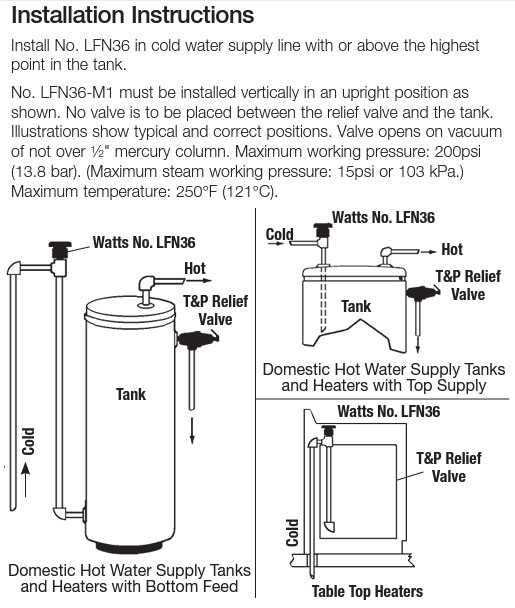JAGDIY
New Member
Hi Experts!
I had a great conversation with the Chief Plumbing inspector for my city in NC today regarding the new hybrid hot water heater I'm about to install (replacing a gas unit) and he made me aware of
504.2 Vacuum Relief Valve
Bottom fed water heaters and bottom fed tanks connected to water heaters shall have a vacuum relief valve installed. The vacuum relief valve shall comply with ANSI Z21.22.
I'm very clear about the valve being installed higher than the top of the tank-portion of the hot water heater, however, in all the installation instructions I've seen, such as, https://www.watts.com/dfsmedia/0533dbba17714b1ab581ab07a4cbb521/11945-source, it seems to show the valve being the highest point in the plumbing line, not just higher than the hwh. In my case the hhwh is in a mechanical room in the finished basement. It is not possible for the valve to be the highest point. In addition, the cold supply to the hot water is running just below the joists so in my scenario the 90 on the line-in side to the T for the valve pictured below would be rotated 180 degrees (so up, not down.) Is this okay and will the valve still be able to do it's thing if a vacuum scenario were to occur?

Thank you in advance.
I had a great conversation with the Chief Plumbing inspector for my city in NC today regarding the new hybrid hot water heater I'm about to install (replacing a gas unit) and he made me aware of
504.2 Vacuum Relief Valve
Bottom fed water heaters and bottom fed tanks connected to water heaters shall have a vacuum relief valve installed. The vacuum relief valve shall comply with ANSI Z21.22.
I'm very clear about the valve being installed higher than the top of the tank-portion of the hot water heater, however, in all the installation instructions I've seen, such as, https://www.watts.com/dfsmedia/0533dbba17714b1ab581ab07a4cbb521/11945-source, it seems to show the valve being the highest point in the plumbing line, not just higher than the hwh. In my case the hhwh is in a mechanical room in the finished basement. It is not possible for the valve to be the highest point. In addition, the cold supply to the hot water is running just below the joists so in my scenario the 90 on the line-in side to the T for the valve pictured below would be rotated 180 degrees (so up, not down.) Is this okay and will the valve still be able to do it's thing if a vacuum scenario were to occur?
Thank you in advance.

